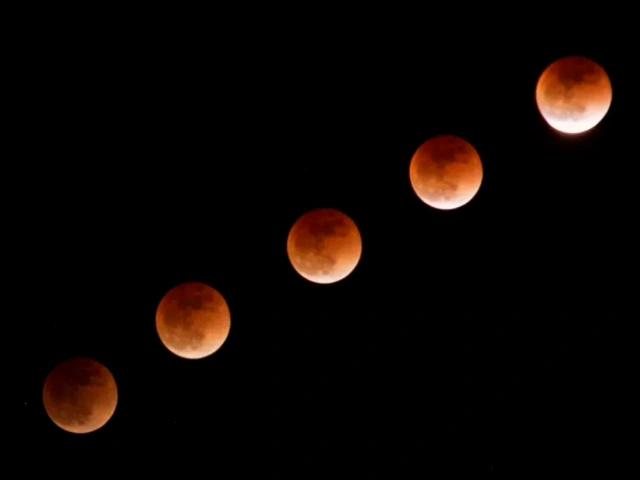Lunar Eclipse Observation Guide: September 7–8, 2025
On the night of September 7th through the early morning of September 8th, 2025, skywatchers across China and much of East Asia will be treated to a breathtaking celestial performance: a total lunar eclipse. For astronomy enthusiasts, this event is particularly exciting because it is the first total lunar eclipse fully visible from start to finish in China since November 2022. Even more remarkable, the totality phase will last an extraordinary 82 minutes, the longest in nearly a decade, offering observers ample time to experience the mesmerizing sight of a glowing “Blood Moon.”
This guide will walk you through everything you need to know: the science behind the eclipse, the exact timeline, practical viewing tips, cultural significance, and even how to capture stunning photos. Whether you are a seasoned stargazer or simply curious about the night sky, this event is worth marking on your calendar.
1. Key Facts at a Glance
Event: Total Lunar Eclipse
Date: Night of September 7 – early morning of September 8, 2025
Visibility: Entirely visible from all of China (weather permitting)
Total Duration: About 5 hours 27 minutes from beginning to end
Totality Phase (Blood Moon): 82 minutes, longest in nearly 10 years
Best Viewing Window: 01:31 – 02:53 (Beijing Time)
Special Note: Easily visible to the naked eye, no equipment required
⏰ 2. Detailed Timeline of the Eclipse (Beijing Time)
A total lunar eclipse unfolds in several stages, each offering its own visual highlights. Below is the full timeline for September 7–8, 2025:
Phase | Time | Description |
Penumbral Eclipse Begins | 23:28 (Sept 7) | The Moon enters Earth’s faint outer shadow (penumbra). Slight dimming begins, but hard to notice. |
Partial Eclipse Begins (First Contact) | 00:27 (Sept 8) | The Moon enters the dark central shadow (umbra). A visible “bite” appears on the lunar surface. |
Totality Begins (Second Contact) | 01:31 | The Moon is completely engulfed in the umbra. The Blood Moon appears. |
Maximum Eclipse | 02:12 | Peak of the eclipse. The Moon glows its darkest red or copper hue. |
Totality Ends (Third Contact) | 02:53 | The Moon starts leaving the umbra. Bright silver light slowly reappears. |
Partial Eclipse Ends (Fourth Contact) | 03:56 | The Moon exits the umbra entirely and shines bright again. |
Penumbral Eclipse Ends | 04:55 | The Moon completely leaves Earth’s faint shadow. The eclipse is over. |
Viewing Tip: The most dramatic and photogenic moments are between 00:27 – 03:56, but the must-watch period is the totality (01:31 – 02:53).

3. Why Does the “Blood Moon” Happen?
Unlike a solar eclipse, which is brief and requires special eye protection, a lunar eclipse is long, gentle, and completely safe to watch. But why does the Moon turn red instead of disappearing?
The answer lies in Earth’s atmosphere. During totality, Earth blocks direct sunlight from reaching the Moon. However, sunlight passing through Earth’s atmosphere is scattered and refracted. Shorter wavelengths, such as blue and green, scatter away, while longer red and orange wavelengths bend and still reach the lunar surface. This gives the Moon its eerie blood-red or coppery glow.
In a sense, during a lunar eclipse, the Moon is illuminated by the combined light of all the sunsets and sunrises happening on Earth at that moment. The exact shade depends on atmospheric conditions—dust, volcanic ash, and cloud cover can all influence the color. After major volcanic eruptions, for example, eclipses have appeared darker and more crimson.
4. The Cultural Significance of Lunar Eclipses
Across history and cultures, lunar eclipses have fascinated, inspired, and sometimes frightened people. Ancient civilizations often viewed them as powerful omens.
In Chinese tradition, a lunar eclipse was once described as a celestial dragon devouring the Moon. People would bang drums or gongs to scare away the dragon and “rescue” the Moon. Today, these myths live on as part of cultural heritage, adding symbolic depth to the spectacle.
In Western folklore, the Blood Moon has often been linked with prophecy, mystery, or change. The striking color and rarity of the event made it a powerful symbol in storytelling.
In modern science and culture, eclipses are opportunities for learning, awe, and global connection. In an age when millions can share real-time photos online, events like the September 2025 eclipse become collective experiences across continents.
5. How to View the Eclipse
The beauty of a lunar eclipse is its accessibility. Unlike solar eclipses, there is no need for protective glasses, filters, or elaborate equipment. Here are some practical tips:
Use Your Eyes First: The eclipse is safe to watch directly. Simply step outside and look toward the east.
Binoculars & Telescopes: While optional, they enhance the details—the curved shadow of Earth, subtle color gradients, and craters glowing under copper light.
Find a Dark Spot: Avoid bright city lights. Parks, open fields, mountains, or high-rise rooftops offer the best conditions.
Plan Ahead: Check weather forecasts. Even partial cloud cover can block your view.
Dress Comfortably: Nights in early September may still be warm in much of China, but in northern regions temperatures can dip. Bring light jackets if needed.
6. Tips for Photographing the Eclipse
Capturing the Moon’s transformation can be both rewarding and challenging. Here are some beginner-friendly techniques:
Tripod is Essential: The eclipse is dimmer than a regular full moon, so longer exposures are required. A tripod eliminates camera shake.
Use Manual Settings: Start with ISO 400–800, aperture f/8, and adjust shutter speed (1–5 seconds during totality).
Time-Lapse Photography: Many smartphones now feature time-lapse modes—perfect for recording the Moon’s gradual changes.
Zoom Lenses: A 200mm lens or greater helps capture detailed close-ups.
Experiment: Colors and brightness shift as the eclipse progresses. Don’t hesitate to try multiple settings.
7. The Science Value of Lunar Eclipses
Beyond their beauty, lunar eclipses also offer scientific insights. Astronomers use them to:
Study Earth’s Atmosphere: The color and brightness of the Moon during totality reveal how much dust, pollution, or volcanic ash is suspended in the air.
Observe Lunar Features: The soft reddish glow highlights surface details that are less visible in full moonlight.
Engage the Public: Eclipses provide an accessible gateway into astronomy, inspiring future scientists and stargazers alike.
8. Historical Perspective
This upcoming eclipse is notable not just for its duration but also for its place in astronomical cycles.
The last total lunar eclipse visible in China occurred on November 8, 2022, but it was shorter in duration.
The 82-minute totality in 2025 is the longest since the decade began, and such long eclipses are rare because they require near-perfect alignment of the Sun, Earth, and Moon.
Ancient Chinese astronomers meticulously recorded eclipses as early as the Zhou Dynasty (1046–256 BCE), using them to refine calendars and predict celestial patterns.
9. A Shared Global Experience
Although this guide focuses on China, the September 2025 eclipse will be visible across much of Asia, parts of Australia, and the Pacific region. For many people around the world, this night will be an opportunity to pause, look upward, and share in a natural wonder that transcends borders.
With modern communication, expect social media to be filled with images of the Blood Moon from diverse locations—mountaintops, rural villages, and bustling cities alike. The eclipse thus becomes not only a scientific event but also a human one, connecting millions in collective awe.
10. Final Thoughts
The September 7–8, 2025 total lunar eclipse is more than just an astronomical event—it is a moment of connection between Earth, Moon, and humanity. With its unusually long totality and complete visibility across China, it promises to be one of the most memorable skywatching opportunities of the decade.
Whether you choose to observe casually with your naked eye, share the moment with friends and family, or photograph it meticulously with advanced equipment, this eclipse invites you to slow down and marvel at the rhythms of the cosmos.
So, mark your calendar, set your alarm, and prepare to witness the Moon transform into a glowing red lantern suspended above the horizon. Events like this remind us that while life on Earth can be hectic, the universe moves to its own grand, timeless cycles—and sometimes, we are fortunate enough to watch.




